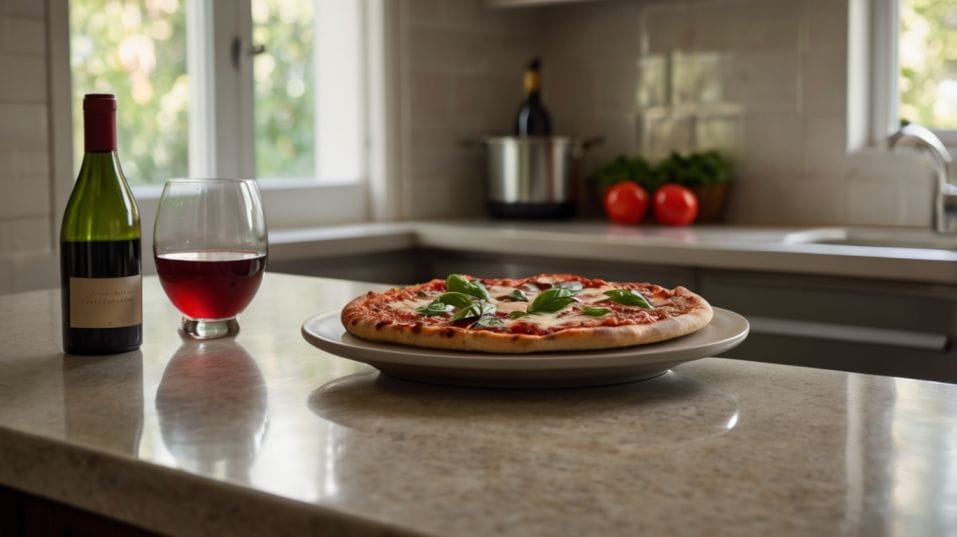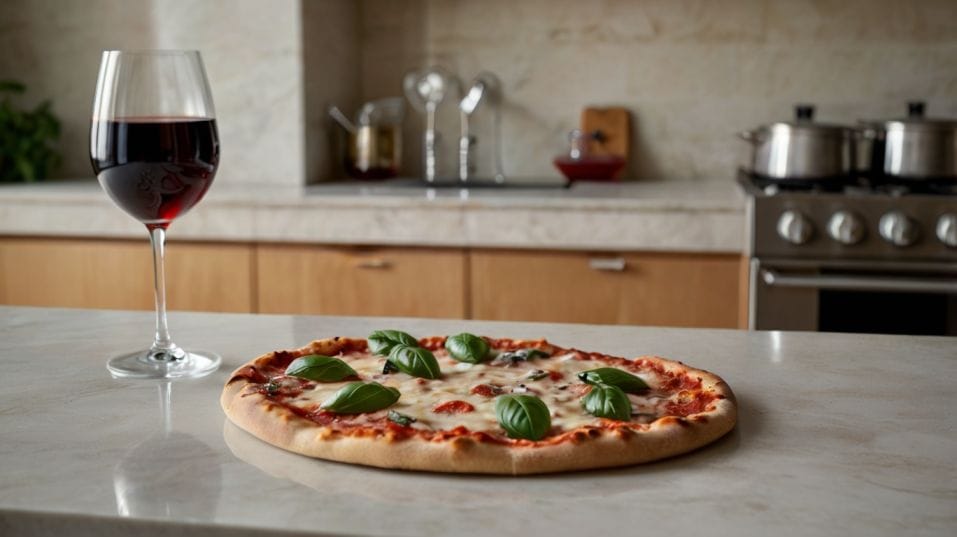The Right Wine for Pizza (Yes, It’s a Thing)
Discover the best wines to pair with every kind of pizza—from spicy to creamy—to elevate your slice and sip smarter with every bite.

What if the best wine lesson is hiding in your next slice of pizza? Forget the beer cliché—pizza isn’t just casual; it’s complex. Cheese, sauce, crust, and toppings offer real flavor signals.
The right wine doesn’t just pair—it elevates. Whether you’re just getting into wine or figuring out what works with dinner, pizza is the perfect place to start. It's not about fancy bottles. It’s about tasting smarter with what’s already in front of you.
Why Wine and Pizza Actually Work
At first glance, pizza seems chaotic—fat, salt, char, acid, spice. But that’s exactly why wine fits. Good wine and good pizza both rely on balance.
They speak the same flavor language. Tomato sauce brings acidity. Cheese adds fat. Toppings bring texture, salt, or heat.
Dough, when done right, adds toast and chew. Wine gives you the tools to respond to all of it: acidity to cut through richness, tannins to grip fat, aromatics to echo herbs, freshness to reset your palate.
You don’t need a cellar or a spreadsheet. You need to think like a cook: what’s the main element, what’s the texture, and how can wine highlight rather than fight it?
Classic Tomato-Based Pizza: Honor the Acid
Most pizza starts with red sauce. That tangy tomato base is your first pairing clue. Tomatoes are naturally high in acid, and they’ll make a flabby wine taste even flatter.
That’s why lush, jammy reds often fall apart next to a slice—they feel heavy and dull. What you want is a wine with equal (or greater) acidity.

Think:
- Chianti Classico: Lean, bright, with just enough grip. The red cherry and herbal notes match beautifully with basil, tomato, and mozzarella.
- Barbera: An Italian red with high acid, soft tannins, and dark fruit—great for meatier toppings.
- Montepulciano d’Abruzzo: Earthy, smooth, and built to match rustic pies.
These wines don’t just match flavors—they cut the fat in the cheese, play nicely with salt, and stand up to the tang in the sauce. That’s structure in action.
White Pizza and Creamy Bases: Match the Texture
Once you remove tomatoes from the equation, acid isn’t the lead player anymore. Cream-based pizzas—ricotta, béchamel, or just olive oil with mozzarella—call for a different approach.
Here, you’re managing texture and richness. You need a wine that complements the creamy mouthfeel without flattening out.
Try:
- Fiano di Avellino: A southern Italian white with roundness, minerality, and just enough acidity to stay lifted.
- Chardonnay (Unoaked or Lightly Oaked): Avoid buttery California styles. Look for versions from Burgundy or coastal Chile. You want stone fruit, citrus, and minerality, not dessert.
- Vermentino or Soave: Bright, crisp, and aromatic—these wines elevate without overwhelming delicate flavors like garlic, spinach, or roasted mushrooms.
This is where white wine shines. Not every wine needs to “cut through”—some are better at gliding alongside.
Spicy Toppings: Stay Cool, Stay Fresh
Pizza with heat—whether from chili oil, hot honey, or spicy meats like nduja or pepperoncini—can overwhelm wines with high alcohol or aggressive tannins.
Spice and alcohol amplify each other. What starts as a gentle tingle becomes a full-on burn. To keep your palate in check, go with juicy, chillable reds and off-dry whites that cool things down and clear the slate.
Look for:
- Lambrusco (Dry Style): Slightly fizzy, refreshing, and low in alcohol. Perfect with sausage or pepperoni.
- Gamay (Chilled): Light-bodied and fruit-forward—great with anything spicy or cured.
- Riesling (Dry or Off-Dry): If you’re brave enough for jalapeños or habanero oil, a splash of sweetness soothes the fire without being cloying.
The goal here isn’t to douse the flame—it’s to let the heat shine, but on your terms.
Meaty, Earthy, and Savory: Depth Without Density
Heavier toppings—mushrooms, sausage, truffle oil, anchovies—pull pizza into deeper, more savory territory. This is where wines with earth, herb, or mineral tones shine.
You’re matching the grounding flavors with wines that have complexity but not bulk. Big-bodied, high-alcohol reds can overwhelm the pizza’s detail. Instead, look for nuance.
Try:
- Etna Rosso: From volcanic soils in Sicily, this wine offers smoky minerality and tart cherry—an ideal match for roasted mushrooms or sausage.
- Pinot Noir (Old World): Light enough for balance, complex enough for depth. Especially good with caramelized onions, fennel, or mushroom-heavy pies.
- Cabernet Franc (Loire): Herbaceous, red-fruited, and lean—great for anchovies, olives, or arugula-topped pies.
You’re not overpowering the pizza. You’re tuning into its savory side.
Don’t Ignore Rosé—and Chill Your Reds
One of the easiest pairing moves most people miss? Chill your red wine. Just 15–20 minutes in the fridge brings out structure, tamps down alcohol, and sharpens flavors.
Pizza loves that. High-temp reds feel flabby next to hot food, especially with cheese and oil in the mix.
And rosé? It's not just a summer sipper. A good, dry rosé (especially from Provence, Sicily, or Tavel) has the structure of a white and the flavor profile of a light red.
That makes it ideal for lighter pies with herbs, fresh tomatoes, or seafood toppings. Plus, it handles variety with ease—which helps if everyone at the table has a different favorite slice.
Final Thoughts
Great wine with pizza isn’t about flexing knowledge—it’s about paying attention. To the sauce. To the crust. To what you like and why it works.
The more you taste intentionally, the more you understand how acid, texture, and flavor interact. That’s real wine confidence.
So next time you reach for a bottle with your Friday night pie, don’t default to the usual. Try something Italian and rustic. Chill a red you’d normally serve warm. Swap your Sauvignon Blanc for Vermentino. Bring a little thought to the table.
Because pizza isn’t just comfort food. With the right wine, it’s your best excuse to taste better tonight.




